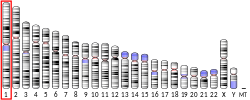Retinylidene proteins, or rhodopsins in a broad sense, are proteins that use retinal as a chromophore for light reception. They are the molecular basis...
12 KB (1,416 words) - 05:06, 29 November 2023
Vertebrate visual opsin (redirect from Gn-x protein-coupled receptor)
opsin binds retinal to form a holoprotein, it is referred to as Retinylidene protein. However, the distinction is often ignored, and opsin may refer loosely...
10 KB (1,049 words) - 21:31, 14 July 2024
Retinal (redirect from Retinylidene)
giving H2O. Retinylidene is the divalent group formed by removing the oxygen atom from retinal, and so opsins have been called retinylidene proteins. Opsins...
33 KB (3,318 words) - 20:15, 11 September 2024
bleaching intensities. The visual cycle occurs via G-protein coupled receptors called retinylidene proteins which consists of a visual opsin and a chromophore...
20 KB (2,366 words) - 05:14, 10 September 2024
receptor protein which triggers a signal transduction cascade. Chromophores found in photoreceptors include retinal (retinylidene proteins, for example...
8 KB (770 words) - 18:35, 10 May 2023
Eyespot apparatus (category Integral membrane proteins)
and retinylidene proteins (rhodopsins). Flavoproteins are characterized by containing flavin molecules as chromophores, whereas retinylidene proteins contain...
7 KB (778 words) - 07:17, 8 March 2024
Opsin (category G protein-coupled receptors)
chromophore, typically retinal. When bound to retinal, opsins become retinylidene proteins, but are usually still called opsins regardless. Most prominently...
86 KB (9,311 words) - 19:43, 15 November 2024
Retinal is a chromophore that forms photosensitive Retinylidene proteins when covalently bound to proteins called opsins. Retinal can be photoisomerized by...
11 KB (1,373 words) - 00:19, 8 November 2023
Channelrhodopsin (category Integral membrane proteins)
Channelrhodopsins are a subfamily of retinylidene proteins (rhodopsins) that function as light-gated ion channels. They serve as sensory photoreceptors...
54 KB (5,967 words) - 02:18, 27 August 2024
ABCA4 (redirect from N-retinylidene-N-retinyl-ethanolamine)
accumulation leads to formation of toxic cationic bis-pyridinium salt, N-retinylidene-N-retinyl-ethanolamine (A2E), which causes human dry and wet age-related...
21 KB (2,758 words) - 23:39, 21 June 2024
Proteorhodopsin (category Bacterial proteins)
the water column. Proteorhodopsin belongs to a family of similar retinylidene proteins, most similar to its archaeal homologues halorhodopsin and bacteriorhodopsin...
18 KB (1,989 words) - 02:11, 13 September 2024
Halorhodopsin (category Integral membrane proteins)
Halorhodopsin is a seven-transmembrane retinylidene protein from microbial rhodopsin family. It is a chloride-specific light-activated ion pump found in...
9 KB (975 words) - 10:17, 19 September 2024
Bacteriorhodopsin (category Integral membrane proteins)
retinal molecule to residue Lys216, via a Schiff base, to create the retinylidene chromophore. Cleavage of the signal peptide, the first 13 amino acids...
21 KB (2,123 words) - 02:13, 27 August 2024
Rhodopsin (category G protein-coupled receptors)
active-site lysine in rhodopsin and implications for evolution of retinylidene proteins". Proceedings of the National Academy of Sciences of the United...
39 KB (4,404 words) - 14:51, 9 November 2024
fatty acid, polyketide, non-ribosomal peptide and leucine biosynthesis retinylidene Schiff base formation diphthamide formation (on a histidine found in...
33 KB (3,191 words) - 03:01, 27 October 2024
base with a conserved lysine residue, and interaction of light with the retinylidene group causes signal transduction in color vision (See visual cycle for...
68 KB (7,547 words) - 20:48, 20 October 2024
used photoactivatable proteins in scientific research, as of 2013, are photoactivatable fluorescent proteins and retinylidene proteins. Photoactivatable fluorescent...
14 KB (1,583 words) - 06:52, 10 July 2024
strong light leads to formation of toxic cationic bis-pyridinium salt, N-retinylidene-N-retinyl-ethanolamine (A2E), which causes dry and wet age-related macular...
16 KB (1,699 words) - 07:34, 3 June 2024
age-related macular degeneration (AMD) is thought to be the toxic byproduct, N-retinylidene-N-retinylethanolamine (A2E). A2E is a major chromophore in lipofuscin...
13 KB (1,455 words) - 05:18, 10 November 2023
PMID 13346046. Shichi H, Somers RL (1974). "Possible involvement of retinylidene phospholipid in photoisomerization of all-trans-retinal to 11-cis-retinal"...
2 KB (151 words) - 15:41, 26 August 2023













